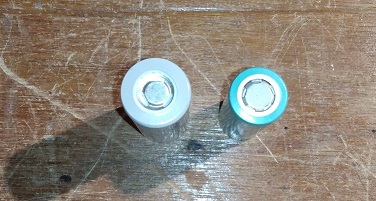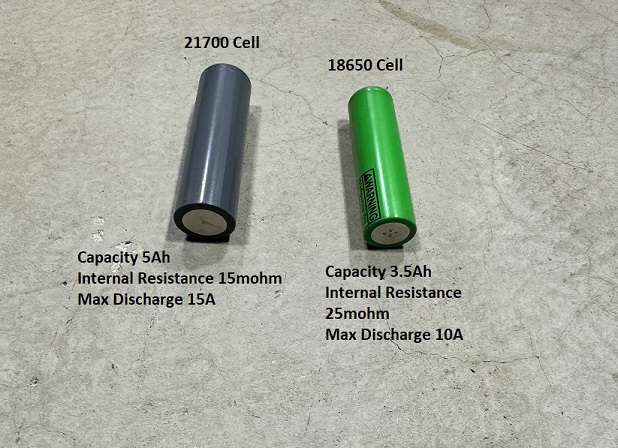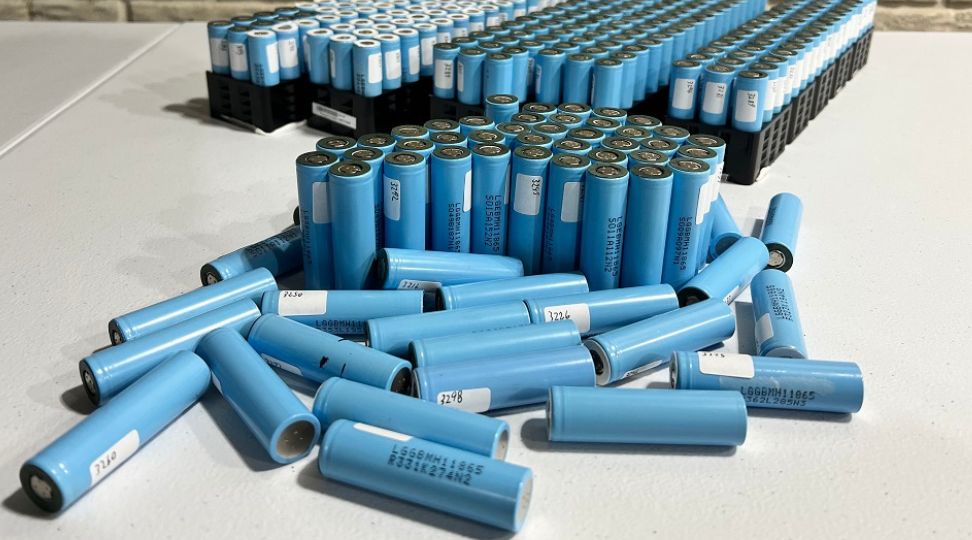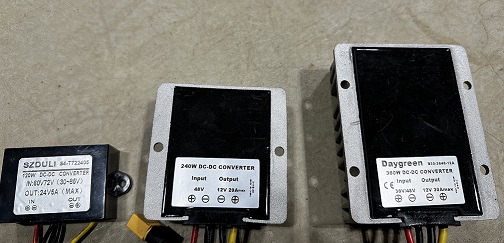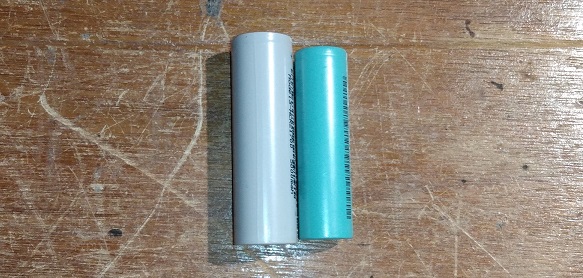
18650 or 21700 Cells, Which Is Best
Table of Contents
When working with lithium-ion batteries, there are many types that you will come across. The overwhelming majority, however, will be either 18650 or 21700 cells. So, you may be wondering which cell type is best for your application.
Generally speaking, 21700 cells are better for most applications. These larger cells contain more watt-hours per cubic centimeter compared to smaller 18650 cells. Also, 21700 cells can generally provide more discharge current and support higher charging currents than 18650 cells. 18650 cells are smaller, so you may not have the option to use 21700 cells. Also, 18650 cells are lower cost per cell and generally a lot easier to find than 21700 cells.
In this article, we will compare and contrast 18650 cells vs 21700 batteries in order to provide you with enough information to determine which cell is best for your use case.
Are 21700 And 18650 Cells The Same
No. These numbers only indicate size, but size plays more of a factor in how well a battery cell works than you may think. 21700 cells are physically larger, so there is more room for energy storage. Also, when it comes to scaling cylinders, as you increase its surface area by a small amount, you increase its volume by a large amount. So, basically, being a little bigger on the outside makes things a lot bigger on the inside. This means that gram for gram and cm³ for cm³, 21700 calls are going to offer the best characteristics more often than not.
21700 cells are not twice as large as 18650 cells but they do often contain twice the power or more. Also, 21700 cells can support very high currents, most of their 18650 counterparts. A 21700 cell can output higher currents due to its often lower internal resistance levels. These three factors are again attributed to the size difference between the cells.
These two battery types provide the same function and are often used in the same application. Both 18650 and 21700 cells are lithium cobalt battery cells and therefore have the same running voltages.
21700 and 18650 batteries offer drastically different performance characteristics due to their size. Because 21700 batteries are larger than 186500 cells, they have superior energy storage characteristics and current carrying capacity. Really, the only advantage of a 18650 other than higher availability is also their main detracting point; their size. If you need to fit a certain amount of cells in series to create a particular voltage, you may have no choice but to use 18650s due to this size constraint.
21700 Battery Vs 18650, Which One Is Better
If you are looking to build a lithium battery pack picking between 2170 cells or 1865 cells can make a big difference. Below we will lay out the main considerations to help you make the choice.
Battery capacity is measured in milliamp-hours (mAh) which can easily be converted to amp-hours (Ah) by dividing by 1000. A 21700 battery cell generally has a rated capacity of about 4000mAh (4Ah) to around 5500mAh (5.5Ah). 18650 cells, on the other hand, have rated capacities of 2600mAh (2.6 Ah) to 3600mAh (3.6Ah). Therefore, most 21700 battery cells have nearly twice the capacity of most 18650 battery cells.
The Molicel P42A is, by far, the highest-performing 21700 battery cell. It has a 4200 mAh capacity (4.2Ah) and can support a continuous discharge current of 45 amps. When it comes to the most popular and sought-after battery cells, that title will have to be given to Tesla cells. If you are wondering what a Tesla cell is, well, it's a pretty much nameless and faceless cell made by either LG or Panasonic. They have a 5000 mAh capacity and only support about 15 amps continuously, but because they were installed in a model 3 for a moment, people really love them.
There are quite a few excellent 18650 cells on the market but we will discuss three here. There are also several options for the highest capacity 18650 cells on the market.
The LG MH1 is commonly used because it provides a good balance between capacity and discharge capabilities. The official model number is INR18650MH1 and these cells support a continuous discharge current of up to 10 amps. LG MH1 cells have a nominal capacity of 3200 mAh and a nominal voltage of 3.6 volts. For the longest cell life, it is recommended to charge LG MH1 cells at 1.5 amps. They can, however, safely be charged at 3 amps, but this will reduce the cells overall lifespan.
Another popular 18650 cell is the Samsung 30Q. This cell is used for the same reasons that LG MH1 cells are, but the 30Q strikes a bit less of a balance. If you need a cell that can handle a little more current than the MH1 and you don’t need the extra capacity, then the Samsung 30Q is perfect for you. These cells have a capacity of 3.0 Ah and a nominal voltage of 3.6 to 3.7 volts. These cells can handle up to 15 amps of continuous discharge current. For the best cycle life, Samsung 30Q cells need to be charged at no more than 1.5 amps per cell. These cells can be safely charged at up to 4 amps, but overall life will be reduced.
The most sought-after cell is by far the Molicel P28A because Molicel. Molicel is the Mercedes Benz of lithium-ion battery cells when it comes to current carrying capacity. Molicel P28A cells have a capacity of 2.8Ah and a nominal voltage of 3.6 volts. P28A cells can handle up to 35 amps of continuous discharge current, and that is not even a typo. 35 Amps per cell continuously is quite a tall order and these cells can do it. For the longest cycle life, P28A cells should be charged at no more than 2.8 Amps but they can safely be charged at up to 6.8 Amps per cell at the cost of some cycle life.
Do 21700 Batteries Fit 18650 Devices
No. 21700 cells are physically larger than 18650 cells. Because of this, it's physically impossible for a 21700 cell to fit in a 18650 cell holder. You can, however, purchase adapter sleeves to make 18650 cells fit into places that are expecting 21700 cells. It's important to keep in mind that doing so will result in a massive drop in energy density.
Does Tesla Use 21700 Batteries
Yes. Not only does Tesla use 21700 batteries, but they also pioneered that format. The Tesla Model 3 was the vehicle by Tesla to use these cells. There are 4416 21700 cells in the Tesla Model 3 and Tesla Model Y.
Can A 18650 Charger Charge 21700
Yes. Any charger that is designed for 18650 cells can charge 21700 cells. Electrically, 18650 and 21700 cells look the same to a charger. The charger does not care about capacity, so it will charge the 21700 cells just the same and it will be none the wiser. While it is true that exceeding the safe current limits can result in damage or fire, it's crucial to note that 21700s can support equal or greater charging currents compared to 18650 cells.
We tested and compiled a list of the best 18650 and 21700 chargers and testers.
Are 18650 And 21700 Cells The Same Size
No. 18650 batteries have that name because they are 18mm wide and 65mm tall. The trailing 0 simply means it's a cylindrical cell. 21700 batteries, on the other hand, are 21mm wide and 70mm tall. This is why 21700 cells cannot fit in the same space that a 18650 can, but a 18650 can fit in the same place as a 21700 can.
Can I Use A 21700 Battery Instead Of 18650 Cells
Yes. As long as you don't have any kind of size constraints, then 21700 cells will work just fine in place of 18650 cells.
Conclusion
So, 18650 Or 21700 cells; which Is best? I would have to say 21700 cells so long as a battery built from them can physically fit in your application.
21700 battery cells are gaining popularity quickly. 21700 battery cells offer more power and more often than not provide more current than 18650 battery cells. This makes 21700 cells ideal for high-current applications like devices like power tools and electric vehicles. While it is true that 18650 cells are still being manufactured, we will more than likely see 21700 replace them as the industry standard for everything but the most compact portable electronics.
We hope this article helped you understand more about 18650 Or 21700 cells and which Is best. Thanks for reading!
